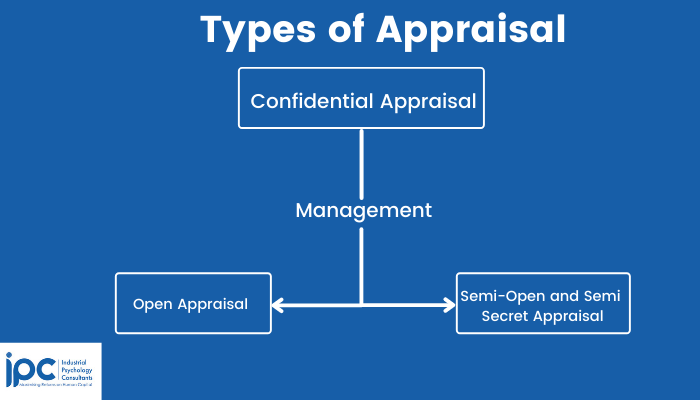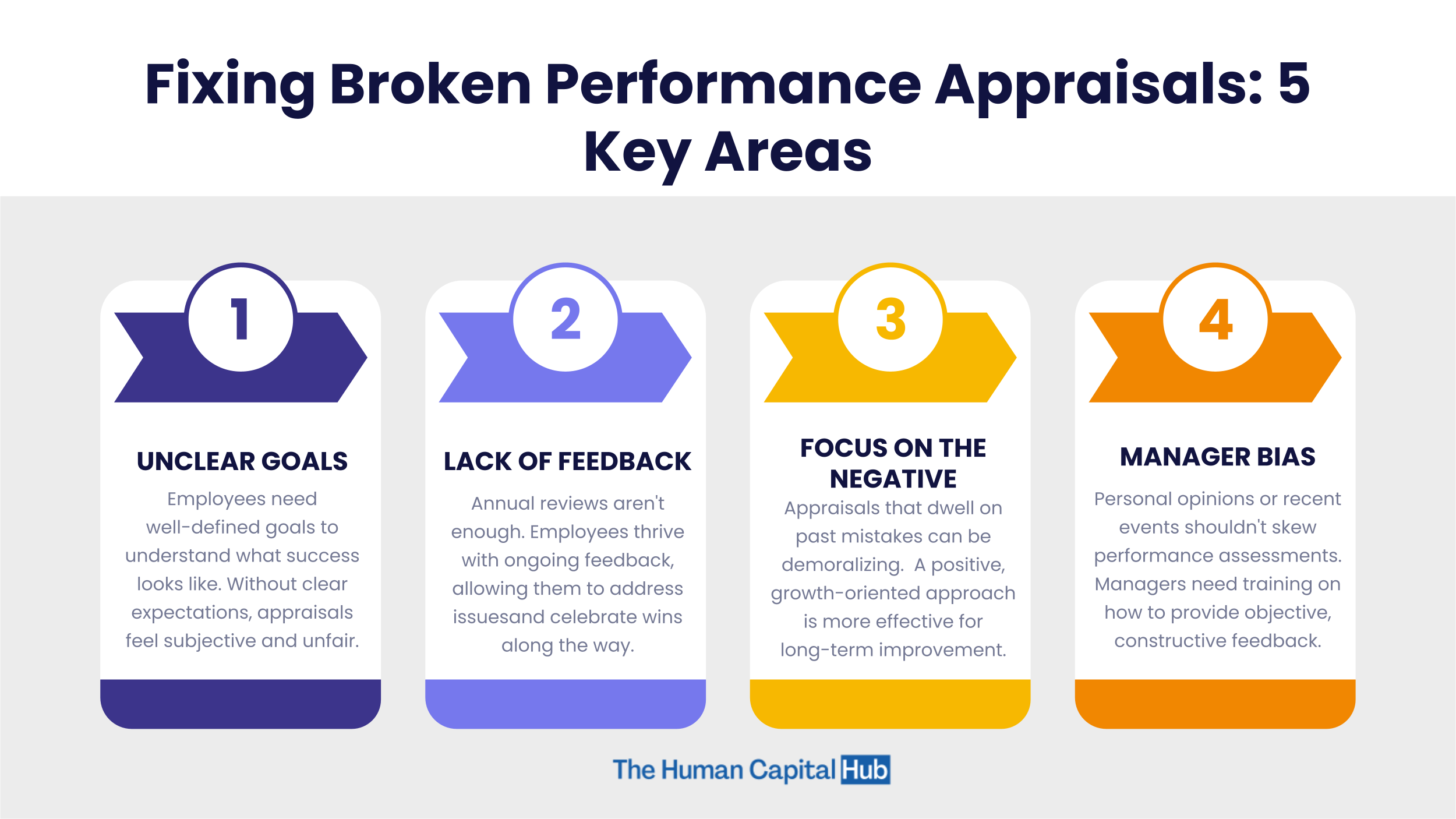Organizational performance and its resultant efficiency and effectiveness can only be achieved when individuals are continuously appraised and evaluated. The inability of an organization to install an effective performance appraisal strategy has hindered them from reaching a competitive advantage which they require more now than ever before (Obisi, 2011). Appraisal processes are not systematic and regular and are often characterized by personal influences occasioned by the organization's preoccupation to use a confidential appraisal system which hinders objectivity and fairness. Often organizations ignore management by objectives, critical incidents to personal prejudices. This is retrogressive as it affects the overall performance of the individual. 360 degrees appraisal method whereby superiors appraise their subordinates, subordinates appraise their superior and the appraisee appraise himself or herself and the average of all the appraisal taken to arrive at the final appraisal outcome should now be considered by organizations (Obisi, 2011).
Performance appraisal defined

Performance appraisal is also known as employee evaluation, merit rating, employee assessment, etc. It is a systematic process of appraising an employee’s current and past performance relative to his/her performance parameters (Bhullar, 2018). The employee’s performance should be based on organizational expectations and the employee’s actual performance (Bhullar, 2018). The idea that performance evaluation improves employee performance is not a new one but it is seen in the roots of the development of humankind. Each person is motivated when he or is told about his actual performance and accepts he were their previous mistakes. The performance appraisal process may be held annually or monthly as needed.
Flippo (1976) defines performance appraisal as, “performance appraisal is the systematic, periodic and impartial rating of an employee’s excellence in matters about his present job and his potential for a better job. Performance appraisal is a systematic way of reviewing and assessing an employee's performance during a given period and planning for his future.
Performance appraisal may be defined as a structured formal interaction between a subordinate and supervisor, that usually takes the form of a periodic interview (annual or semi-annual), in which the work performance of the subordinate is examined and discussed, to identify weaknesses and strengths as well as opportunities for improvement and skills development.
Concept of performance appraisal
Advertisment
Virtually all organizations have some sort of means of appraising their employees. Performance Appraisal is one of the oldest, most natural, and most universal practices of Management (Bhullar, 2018). The basic purpose of performance appraisal is to ascertain the behavior of an employee anchored to performance and integrate with organizational performance. It helps both employers and employees to understand the responsibility in the organization. The performance appraisal system is focused to integrate the expectations i.e., performance, which gives total clarity between the appraiser and appraisee (Bhullar, 2018). It is an instrument to create a conducive atmosphere in the organization. The purpose of any management is to build a very competitive and congenial work culture, which builds healthy competition, and gives a sense of achievement to the employees and the stakeholders.
A performance appraisal system is the right instrument that plays a vital role directly or indirectly in achieving the above. It improves the interpersonal relationship between the employees and employers in the organization. It reflects an evaluative judgment of the traits, characteristics, and work performance of the employees on jobs (Bhullar, 2018). It is a continuous process to reach the desirous goal of not only the organization but also the employees.
According to Levinson (1996), Performance Appraisal has three functions:
- It seeks to provide adequate feedback to each individual for his or her performance.
- It purports to serve as a basis for improving or changing behavior toward more effective working habits.
- It aims at providing data to managers with which they may judge future job assignments and compensation.
Related: Performance Review Phrases & Comments
Types of appraisal
Truly speaking, there are three types of appraisal. These include a confidential or secret appraisal, and open appraisal and we also have semi-open and semi-secret. However, Mamoria (1995) and Ryars and Rue (1979) identified two types of appraisal, confidential and open appraisal.

1. Confidential Appraisal
In confidential appraisal, Murthy (1989) writes that the individual is not involved in the appraisal exercise as the appraisal outcome is not at all communicated to the person being appraised. In essence, the person’s strengths and weaknesses are not communicated to him or her. Obisi (1996) adds that some managers and supervisors involved in performance appraisal ignore periodic counselling after an incident has taken place.
2. Open Appraisal
The open appraisal system reveals to the appraisee his or her strengths and weaknesses, his contributions, and failures which are discussed with him or her during a performance counselling interview. Mukundan (1989) writes that an open appraisal method would reveal and create self-awareness, which is a process of giving insight into one’s performance. It helps the employee become more reflective and objective about himself and future planning, which establishes an action plan for the coming year in terms of fixing targets, activities, responsibilities, etc. It also makes the employee aware of his key performance areas and the contribution that he is making to the organization.
3. Semi-Open and Semi Secret Appraisal
This is an appraisal process whereby the performance appraisal procedure would be made open at the beginning and later made secret. For instance, if an appraiser is asked to fill out an appraisal form and the superior rates the subordinate and returns his rating to the subordinate to sign and after signing, the subordinate would not hear anything again about his final performance outcome. In some cases, the subordinate would be given the form to fill and after filling and returning the form, the subordinate receives no further communication.
Objectives of performance appraisal
In the words of Cummings as quoted by Bhullar (2018), “the overall objective of performance appraisal is to improve the efficiency of an enterprise by attempting to mobilize the best possible efforts from individuals employed in it. Such appraisals achieve four objectives including the salary reviews, the development, and training of individuals, planning job rotation, and assistance promotions.”
The major objectives of performance appraisal are summarised below:
- To assist in promotions, transfers, and lay-off decisions.
- To make aware to the employee of his actual performance.
- To meet organizational expectations with employees' objectives.
- To assess the training and development needs of the employees.
- To plan job rotation.
- To improve communication between managers and subordinates.
- To assist in decisions regarding salary increases.
- To provide feedback and guidelines for employees for better performance.
- To instill activeness and inspiration or higher goals in employees.
- To determine HR programs for selection, training, and development and to evaluate their effectiveness.
Constituents of performance appraisal
The followings are the main constituents of performance appraisal:
- Job Description: It involves the listing of essential functions and the tasks to be done under each job. It is a process of systematically collecting, analyzing, and documenting important facts about a job. It also provides a basis for job-related selection procedures and performance standards. It specifies:
- The specific job functions and tasks.
- The functions and duties are essential.
- The percentage of time typically spent performing each function.
- The skills, knowledge, and abilities required to perform the job successfully.
- The physical and mental requirements of the position.
- Performance Standards: These describe the standard of performance or describe how well a job should be performed. The defined performance standards offer a benchmark to evaluate the actual work performance. When standards are developed in collaboration with the employees for whose positions they are being developed. It is more likely that the standards will:
- Be appropriate to the requirements of the job.
- Reflect on the realities of the work context and conditions.
- Be understood by the employee and performance manager.
- Be accepted by the employee and the performance manager.
To achieve these objectives, managers must ensure that the written down performance standards are:
- Realistic and job-specific
- Based on measurable data, observation, or verifiable information
- Consistent with organizational goals
- Challenging
- Clear and understandable, and they are dynamic.
Methods of performance appraisal system
One can classify the methods of performance appraisal under two categories-vis-à-vis, traditional and modern methods. Each method has been listed below:
1. Traditional method
The followings are the main traditional methods:
- Essay appraisal method
- Straight ranking method
- Paired comparison
- Critical incidents method
- Field review
- Checklist method
- Graphic rating scale
- Forced distribution
2. Modern Methods (New concepts)
- Assessment centres
- Behaviorally anchored rating scales
- The human resource accounting method
- 360 Degree performance appraisal:
- Self-appraisal
- Superior’s appraisal
- Subordinate’s appraisal
- Peer appraisal.
The positive result of performance appraisal
The following are some of the main positive results of performance appraisal:
- The person whose performance is appraised may develop an increased motivation to perform effectively.
- The self-esteem of the person being appraised may increase.
- The job of the person being appraised may be clarified and better defined.
- Valuable communication can take place among the individuals taking part (that also includes communication between the subordinate and the superior).
- Rewards such as pay and promotion can be distributed on a fair and credible basis.
- Organizational goals can be made clearer, and they can be more readily accepted.
- Valuable appraisal information can allow the organization to do better manpower
- planning, test validation, and development of training programs.
- Better and timely service provision, thus greater citizen satisfaction.
- Makes bureaucrats more accountable for their actions. So it is a change of attitude from the old notions of public administration.
Negative results of performance appraisal
The following are some of the main negative results of performance appraisal:
- The self-esteem of the person being appraised and the person doing the appraisal may be damaged.
- A large amount of time may be wasted.
- The relationship among the individuals involved may be permanently worsened thereby creating organizational conflicts.
- Performance motivation may be lowered for many reasons, including the feeling that poor performance measurement means no rewards for performance (i.e. biased evaluation including favouritism towards some employees).
- Money may be wasted on forms, training, and a host of support services.
Performance appraisal failure

Performance management systems, which typically include performance appraisal and employee development, are the “Achilles’ heel” of human resources management (Pulakos, 2004). They suffer flaws in many organizations, with employees and managers regularly bemoaning their ineffectiveness. A survey by Watson Wyatt (2004) showed that only three out of 10 workers agree that their company’s performance management system helps improve performance. Less than 40 per cent of employees said their systems established clear performance goals, generated honest feedback, or used technology to streamline the process. While these results suggest that there may be poorly designed performance management systems in many organizations, it is typically not poorly developed tools and processes that cause difficulties with performance management. Rather, difficulties arise because, at its core, performance management is a highly personal and often threatening process for both managers and employees (Pulakos, 2004).
Reasons why performance appraisals fail
Research and case studies done by various institutes organizations & firms reveal the following as some of the key reasons for the failure of performance appraisal systems in many organizations:
1. Manager’s judgment or assessment based on preferences
Many times, performance managers provide their personal views, judgments, and more opinion other than the performance appraisal parameters (HR Help Board, 2020). They keep their biased view upfront of measuring and analyzing employee performance against the assigned goals and objectives. They show less interest in the performance appraisals system and belief in their method of performance judgments
2. Unstructured methods of performance appraisal systems
Many organizations do not set the parameters for measuring the performance levels of employees (HR Help Board, 2020). Performance managers include “primary result areas” in the performance appraisal system, but do not include “primary performance indicators” which result in the qualitative appraisal system instead of quantities appraisal. So this approach involves lots of managers’ perceptions, views likes or dislikes, and personal side favours. Such appraisal processes also lack a feedback system between employees and managers.
3. Lack of interest and ownership of the manager
The performance appraisal process is long and time-consuming (HR Help Board, 2020). This process involves lots of talksdiscussionsn, feedback, and designing techniques for managers. Most of the time managers do not show much engagement and interest in designing and developing performance standards and setting goals for their team members objectively (HR Help Board, 2020). In other words, instead of a collaborative approach of the human resources department, function/ department head, and reporting manager, whereas it becomes a coordinating approach for executing this activity in a few organizations.
4. Lack of a proper channel of communication
In many organizations, managers avoid giving direct acknowledgement to employees regarding their performances (HR Help Board, 2020). They resist and close the channel of exchanging feedback with their subordinates.
5. Lack of reward and recognition policy
In many organizations, management avoids giving rewards and recognition to the employee performer in view to avoid any business or unrest among other team members (O’Reilly, 2020).
6. Lack of leadership
Implementation performance appraisal system in an organization is the responsibility of the organization's management and its supervisor/managers respectively. In the lack of proper leadership, supervision, and communication channels network system, an organization loses its objectivity for employees( O’Reilly, 2020). Performance appraisal is a continuous process that approaches from top-level to bottom in an organization.
7. Lack of designing, monitoring, and measuring the performance appraisal standards
Performance appraisal is a continuous process that should be developed, designed, and monitored by managers for successful implementation (O’Reilly, 2020). In the absence of such practices, it is difficult to collect information, measure, analyze, and use it for the decision-making process. As a result, employees felt demotivated and lost their confidence in this system (O’Reilly, 2020).
8. Goals aren’t in the picture
In many organizations, employee goals aren’t in the picture when the performance review process is carried out (O’Reilly, 2020). Sometimes performance management also fails because the wrong goals are chosen to optimize the performance of the employees. In short, goals are important to keep employees motivated and perform better.
9. Lack of communication
Sometimes, managers cannot communicate what they expect from their employees. They need to communicate properly with the employees about the benefits of performance management (O’Reilly, 2020). Employees should be provided with the necessary resources to constantly improve themselves and know the importance of continuous learning and a performance management system.
10. Overemphasizing recent performances
This is one of the most common mistakes that managers/ HRs make. Performance management processes are plagued with various biases in general. Recency bias is one of them. This is an unconscious bias since part of the problem can be attributed to memory and the way the mind makes associations. But it is a dangerous bias all the same. Very simply, it is because recency bias can make or break a performance review. So overemphasizing recent performance can fail the performance management system.
11. Annual performance evaluation
Performance evaluation is valuable only when it is carried out regularly. An annual performance review is not enough for any organization. Some managers claim that it consumes a major portion of their time. But if performance evaluation is carried out annually, employees have to wait for a year to give or receive feedback; which is not good for the organization’s productivity.
12. No recognition/ rewards
Appreciation and recognition are very important to keep your employees inspired and to drive productivity (O’Reilly, 2020). A performance management system that doesn’t include recognition and rewards for employee performance tends to fail more easily. It is important to keep track of employee performance and appreciate their good work (O’Reilly, 2020).
13. Potential rating scale appraisal problems
Potential rating scale appraisal problems can include the following and these can impact negatively performance appraisal and cause it to be a failure.
- The Halo Effect
- Contrast Error
- Rater Bias
- Central Tendency Error
- Leniency or Severity
- Sampling Error
- Primary and Recency
Conclusion
In most cases, it has been found that in organizations performance appraisal systems defeat the purpose of achieving their intended purposes and objectives. There may be numerous causes of such failure, but mostly it occurs as the top management fails to share information and extend support. These failures of performance appraisal can be attributed to ambiguous performance standards, rater bias, lengthy process of form filling and documenting, and wrong selection of performance criteria. At times, the appraisal process itself may be conflicting. A reward-aligned performance appraisal may conflict with administrative and developmental needs.
Milton Jack is a Business Consultant at Industrial Psychology Consultants (Pvt) Ltd, a business management and human resources consulting firm.
LinkedIn: linkedin.com/in/milton-jack-9798b966
Phone: +263 242 481946-48/481950
Mobile: +263 774 730 913
Email: milton@ipcconsultants.com
Main Website: www.ipcconsultants.com
